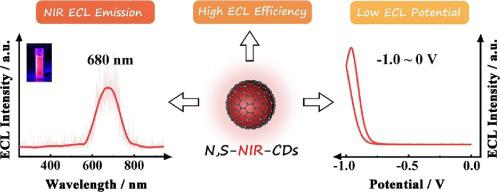The carbon dots with near-infrared electrochemiluminescence emission and low excitation potential for ultrasensitive analysis of microRNA-222
IF 13.3
1区 工程技术
Q1 ENGINEERING, CHEMICAL
引用次数: 0
Abstract
In this work, nitrogen and sulfur codoped near-infrared emission carbon dots (N,S-NIR-CDs) were used as neoteric electrochemiluminescence (ECL) emitters with high efficiency to construct a biosensor for ultrasensitive analysis of microRNA-222 (miRNA-222), which has been regarded as prospective biomarkers for early cancer diagnosis. Impressively, compared to conventional CDs with short ECL wavelength and large excitation voltage, N,S-NIR-CDs possessed wide sp domains and narrow band gap, leading to the near-infrared ECL emission at 680 nm and low excitation potential from −1.0 to 0 V, which not only decreased the photochemical damage for biomolecules but also reduced the side reaction. Moreover, an improved T7 Exonuclease induced cascade amplification (EICA) strategy was designed to transform trace miRNA-222 into plentiful output DNA in dual-cycle for greatly improving the target conversion efficiency. Therefore, by combining the N,S-NIR-CDs as neoteric ECL emitters and EICA strategy as signal amplifier, the constructed ECL biosensor could realize the ultrasensitive analysis of miRNA-222 with a identification limit of 5.65 aM and successfully employed in miRNA-222 analysis from liver cancer cell (HCCLM3 and MHCC-97L) lysate. This strategy developed a kind of neoteric CDs with NIR ECL emission and low excitation potential to establish a highly efficient biosensor for biomarker analysis, which prepared a road for early diseases diagnosis and lied a foundation for biological ECL imaging.

用于超灵敏分析 microRNA-222 的具有近红外电化学发光发射和低激发电位的碳点
本研究采用氮硫共掺杂的近红外发射碳点(N,S-NIR-CDs)作为新同位素电致化学发光(ECL)发射体,构建了一种超灵敏分析microRNA-222(miRNA-222)的生物传感器,miRNA-222被认为是早期癌症诊断的前瞻性生物标志物。令人印象深刻的是,与ECL波长短、激发电压大的传统CD相比,N,S-NIR-CD具有宽sp域和窄带隙,可在680 nm波长处发出近红外ECL,且激发电位在-1.0至0 V之间,不仅减少了对生物大分子的光化学损伤,还降低了副反应。此外,还设计了一种改进的 T7 外切酶诱导级联扩增(EICA)策略,通过双循环将痕量 miRNA-222 转化为大量输出 DNA,大大提高了目标转化效率。因此,通过将N,S-NIR-CDs作为新的ECL发射体,EICA策略作为信号放大器,所构建的ECL生物传感器可以实现对miRNA-222的超灵敏分析,鉴定限为5.65 aM,并成功应用于肝癌细胞(HCCLM3和MHCC-97L)裂解物中miRNA-222的分析。该策略开发出了一种具有近红外ECL发射和低激发电位的新型CD,建立了一种用于生物标记分析的高效生物传感器,为早期疾病诊断铺平了道路,也为生物ECL成像奠定了基础。
本文章由计算机程序翻译,如有差异,请以英文原文为准。
求助全文
约1分钟内获得全文
求助全文
来源期刊

Chemical Engineering Journal
工程技术-工程:化工
CiteScore
21.70
自引率
9.30%
发文量
6781
审稿时长
2.4 months
期刊介绍:
The Chemical Engineering Journal is an international research journal that invites contributions of original and novel fundamental research. It aims to provide an international platform for presenting original fundamental research, interpretative reviews, and discussions on new developments in chemical engineering. The journal welcomes papers that describe novel theory and its practical application, as well as those that demonstrate the transfer of techniques from other disciplines. It also welcomes reports on carefully conducted experimental work that is soundly interpreted. The main focus of the journal is on original and rigorous research results that have broad significance. The Catalysis section within the Chemical Engineering Journal focuses specifically on Experimental and Theoretical studies in the fields of heterogeneous catalysis, molecular catalysis, and biocatalysis. These studies have industrial impact on various sectors such as chemicals, energy, materials, foods, healthcare, and environmental protection.
 求助内容:
求助内容: 应助结果提醒方式:
应助结果提醒方式:


